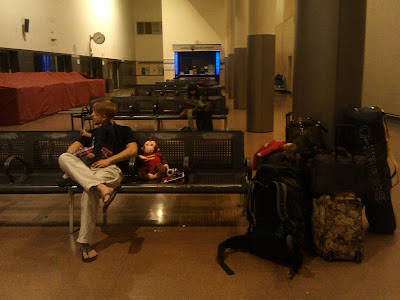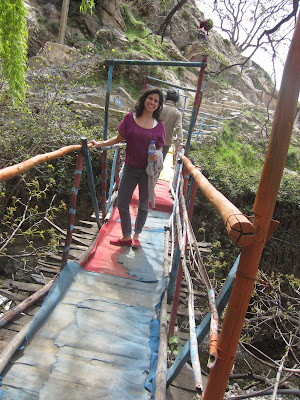It was a little over a year ago that Billy got the email saying that he had been accepted as an intern at a certain large corporation headquartered in Wisconsin. We both collectively breathed a sigh of relief since the main goal of most first year business school students was to get a decent internship and possibly land a job from it. We had heard great things about this corporation and so decided that we would keep an open mind about it and about possibly living in Wisconsin.
About a month into Billy's internship, he came to the harsh realization that he wasn't meant for corporate life. He needed to be passionate about his work if he was going to be putting in 50-60 hours of his time every week into it. I was in SLC at the time, struggling with my own decision to leave my PhD program, so I didn't really see the changes occurring within my husband, but I could hear how sad he sounded over the phone and how unfulfilled he seemed. I sent him a link that evening to a website called
Escape the City, which helps professionals connect with "opportunities outside the corporate mainstream" and that, I think, was how the ball got rolling.
We started thinking about the types of jobs that would motivate us, push us to work hard for our employers. The types of jobs where we could feel amazing at the end of the day, having made a significant difference for some person or organization. We searched and searched and nothing ever seemed right. After spending 6 years thinking about reproductive epidemiology (and having loved learning about it), I felt that I needed to do something different...that the life of an academic wasn't calling out to me anymore. Problem was that I didn't know what I wanted to do. I was, for the first time in a long time, completely uncertain about my professional future. What I did know with 100% certainty was that I loved spending time with my son and my husband. I knew that one day, my time would run out with the both of them and the thought of spending more time away from them doing something that I didn't truly love really hurt.
After having several discussions about what we wanted from life, we realized that the answer was already there: our little company in SLC gives us the best of both worlds. It would allow us to work together and it meant working for something we both believed in: showing kids that learning can be fun. We were silly to look elsewhere. We decided that we would try to expand one part of our company by forming partnerships with international schools all over the world. We used being in Spain as our jumping-off point and have, to date, had meetings with schools in Spain, Slovakia, Portugal, Greece, and Italy (with some solid "maybes" in Bulgaria, Slovenia, Lithuania, Hungary, and Serbia).
So, how do we make this life work? We must be soooo rich, right, to be jumping around from country to country, not really "working." Well, the truth is, we're really not. We live on less than $100 a day for a family of three. How? We're basically homeless in the sense that we don't own or rent a brick-and-mortar home in a city somewhere. We live a few months at a time in different cities, finding most of our accommodations on Airbnb or similar websites. We choose countries where the exchange rates are in our favor. We cook a lot and eat out sparingly. We try to be picky about what sights we see and how much we are really willing to pay to see the baby Elephant at the Zoo or to see the view from the top of the Cathedral. We travel budget airlines and via train. We reuse plastic baggies and save take-out containers. Bottom line, we live pretty frugally. Although it has been an adjustment, living in Europe has actually made it pretty easy to be frugal. For example, our fridge is a squat little thing. I make almost-daily trips to the market to buy our fresh fruits and vegetables because they simply cannot fit in our fridge. We consume much less food here than we did in the states.
Here's an example of our daily budget while living in Budapest, Hungary:
$25 for half a week's worth of groceries
$14 for lunch for 3 people, and we took leftovers home, which provided us with a second meal
$11 for rent for our place (it's about 300 euros a month)
$5 for the bottle of rose champagne I just NEEDED
$10 for my art class
$7 for my yoga class
Of course we have bills on top of that: student loans, health insurance, and a credit card bill (which we use primarily for the decent exchange rate and the airline miles). We are currently in the process of selling our two cars along with pretty much everything we owned (minus a few sentimental items) so that we don't have car payments, car insurance, and storage facility rentals holding us down. We also don't have a phone bill, since we have figured out how to use the wifi capabilities of our phone to our advantage.
Basically, we live on less money traveling around Europe than we did in the States. When we did our budget and came to that realization, we almost didn't believe it. It reinforced our decision to forego a traditional trajectory (marriage + work + house) and to make the most of our next few years as a family traveling and experiencing the world (and saving money!). And although I wish it were possible to spend the next 3 or 4 years visiting every single country on the planet (
like this awesome family), we have decided instead to focus on the countries we have always wanted to visit along with the countries that have the most American International Schools in the area and "live" there for the most time allotted by tourist visas (usually 3 months). This gives us the unique opportunity to not only see what needs to be "seen" as a tourist, but to learn the basics of the language, learn how to cook the traditional dishes, and interact with the locals (I can't tell you how awesome it is to walk down my street in Budapest and be recognized by some of my neighbors) in a way that wouldn't be possible if we only stayed for a few weeks.
Currently, we plan to leave Budapest the day our visa expires (September 2nd) and will go back to St. Louis to sell all of our stuff. Our plan for 2014 is to live in South America (Colombia, Ecuador, and Peru are top contenders now) and focus on drumming up business down there (and finally letting Des immerse himself 100% in a Spanish-speaking environment). I am so excited and so thankful for all of the seemingly innocuous choices Bill and I have made in our lives that have led us to this place. Leaps of faith really do work...




























































































